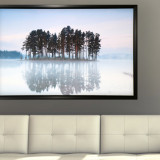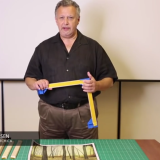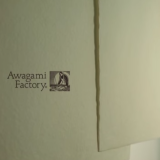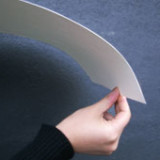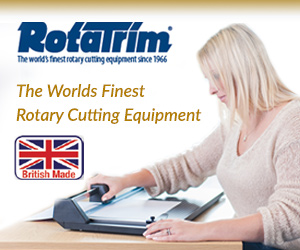Awagami Inkjet Paper (AIJP) has been developed to display colors accurately, but they are not intended to imitate western-style professional papers. A.I.J.P preserves the tactile feel of washi while improving on common washi print issues ie: accurate color reproduction and color bleed. AIJP papers are coated in order to improve ink fastness and overall printing quality. A thicker coating would bring these papers closer to western-style professional paper, but ‘printer-friendliness’ is only one aspect of fine art papers. Since there are already many satisfactory western-style inkjet papers available, we have worked hard to develop our unique family of papers that are both printer-friendly and also retain the refined aesthetic and feel of true Japanese washi.
Clean any debris from the printing head and make sure the paper is flat before printing.
| If the paper is curved, it may get stuck going through the printer. Flatten the paper with your hands. In locales with high humidity (such as Japan), it is best to use the paper immediately after removing it in order to avoid potential warping. If the paper does become slightly warped, gently bend the paper to return it back to flat. Handmade washi paper sheets (‘Bizan’ and ‘Shiramine’ postcards) have 4 deckled edges which may be thicker and/or feathered. Smooth the paper flat before printing so the edges do not catch on the print heads. If the print heads touch the paper, the sheet may get dirty and the nozzles can also become clogged.  The above image is an example of when warped paper has caused the print heads to smudge the paper. |
 |
Before printing with washi inkjet paper, brush away any paper dust.
Brush away any paper dust. This will prevent the dust from sticking to the printer which can cause misprinting.
Printable side
With AIJP paper, the side facing up in the package is the printable side.
Mitsumata Double Layered
Only the front side can be printed.
Kozo
Only the front side can be printed.
Kozo Double Layered
Only the front side can be printed.
Unryu
Only the front side can be printed.
Inbe
Both sides can be printed.
Inbe can be printed on both sides, but the two sides have different textures. One side is smooth, and the other is slightly rough. The ink reacts more or less the same way on each side.
Bizan
Only the front side can be printed.
‘Bizan’ is made entirely handmade one sheet at a time by our master craftsman, and then air-dried on boards. The reverse side of the paper (which had been touching the board) is not coated and therefore not recommended for inkjet printing.
Premio Series
Only the front side can be printed.
Shiramine Postcards
Only the front side can be printed.
The ‘Shiramine’ postcards are made entirely handmade one sheet at a time by our master craftsman, and then air-dried on boards. The reverse side of the paper (which had been touching the board) is not coated and therefore not recommended for inkjet printing.
Example of printing on the back and front sides of Premio series paper

(c)maruyama mitsuko
The left image is a print using the front side, and the right shows one using the back side.
‘Premio’ series papers are backed with uncoated washi (such as ‘Shin-Inbe’), so the backside is not recommended for inkjet printing, however, it can in fact be printed on. Since there is no coating on the papers backside, photographs and detailed graphics will not print clearly, but type and simple illustrations will. At Awagami, we regularly produce double-sided postcards with ‘Premio Series’ papers; printing a photographic image on the front and our logo with text on the backside.

Both dye ink and pigment ink will work! Be sure to check the paper thickness.
We have not yet tested every printer so it’s impossible to make a definitive statement, however it seems that each printer will have its own limits for paper thickness. The thickest papers in the AIJP series are: ‘Bizan’ which can be from 0.3 to 0.7mm (depending on the type) and ‘Shiramine’ postcards which are 0.46 to 0.5mm. If your printer is unable to handle thick papers then the printing surface may get smudged. For certain printers, ‘Shiramine’ postcards and ‘Bizan’ may need to be given a gentle push to start feed smoothly, however, if the paper is aggressively forced it can result in printer malfunction.
All other AIJP papers are 0.3mm or less, so they can easily be used in most printers. As with all fine art papers, you should check with your printer’s manual before printing.

A guide to setting up Awagami Factory-recommended printers.
Epson
*Media TypePhoto paper / matte paper / photo matte / superfine More ink is used with “photo matte” than with “superfine.” Consider the aesthetic of the work when choosing a printer setting. *Print QualityQuality (Level 5) |
*Loading the PaperMost printers should be fine with automatic paper feeding. |
 |
*Paper Size
Select the size of the AIJP paper you will be using.
‘Bizan’ handmade paper has organic deckled edges so it is naturally a tiny bit uneven. Measure the paper to be printed, and adjust the printing size using a custom setting. It’s important to know the eccentricities of your printer as many tend to print with margins slightly off center. You may like to adjust for a slightly wider margin when printing on ‘Bizan’ and other true handmade papers
*Borderless
Papers like ‘Bizan’ and ‘Shiramine’ Postcards (with 4 deckled edges) have uneven edges so they shouldn’t be used for borderless printing. If the borderless printing feature is used, the ink may seep into the paper from the edges. All other AIJP papers (w/out deckled edges) can easily be printed with or without a border.
Canon
*Media TypeMatte Photo paper *Print QualityHigh |
 |
Loading the PaperMost printers will have no problem with the automatic paper feeding setting. |
*Paper Size
Select the size of the AIJP paper you will be using
‘Bizan’ handmade paper has organic deckled edges so it is naturally a tiny bit uneven. Measure the paper to be printed, and adjust the printing size using a custom setting. It’s important to know the eccentricities of your printer as many tend to print with margins slightly off center. You may like to adjust for a slightly wider margin when printing on ‘Bizan’ and other true handmade papers
*Borderless
Papers like ‘Bizan’ and ‘Shiramine’ Postcards (with 4 deckled edges) have uneven edges so they shouldn’t be used for borderless printing. If the borderless printing feature is used, the ink may seep into the paper from the edges. All other AIJP papers (w/out deckled edges) can easily be printed with or without a border.

A printer profile is a data-set used to match the settings of a printer with a properly calibrated monitor and a particular paper. With the correct monitor and printer profiles, it is possible to freely control the print results.
→For more details about ICC profiles.

Awagami Inkjet Papers are made of carefully selected materials, precisely coated and ph-balanced for superior longevity. AIJP papers can be used with both pigment and dye based inks. Use AIJP with your printers various functions to create something artistically unique with its own individual character. We recommend contacting your printer’s manufacturer if you have questions regarding different inks. Here at Awagami Factory, we primarily use ‘matte black’ for the majority of out fine art printing.
Pigment Ink
Pigment ink is often described as being like oil paint. During printing, the colors are applied to the surface of the paper like paint (the ink isn’t absorbed into the paper) and is very durable and lightfast. With printers that use the absolute minimum of ink, the tiniest details in photographs can be reproduced without a grainy effect. Pigment ink has been known for being slightly difficult to achieve a rich glossy finish, but recent improvements have resulted in an improved and stable luster. Pigment ink (with its high durability) paired with AIJP washi (which has always had high durability and low bleed) results in prints that will undoubtedly remain stable for a very long time.
Dye Ink
Just as pigment ink is likened to oil paint, dye ink can be likened to watercolors. Dye inks are not very water-resistant so it tends to soak more into the paper the ink to potentially causing bleed. However, excellent advances are being made with dye ink regularly and some new products proclaim very good storage stability. Dye ink has a very good color range and even the smallest subtleties in color can be expressed ie: the most nuanced of skin tones. Bleeding can happen with regular papers or washi that hasn’t been coated, but since AIJP has been coated for inkjet use, there is no noticeable bleed problem.

Image Resolution
Output size is generally set at about 300dpi.
Print Resolution
Generally, the higher the resolution setting on the printer, the better the image will print.
If the setting offers a choice between “Normal” and “Fine”, choose “Fine”.

Every paper in the AIJP series is coated with the same specialized coating material.
AIJP series papers are all coated with the same original coating, so it is possible to use a different kind of paper for a test print before creating your final print. For example, you may use AIJP “Kozo” for a test print and then AIJP “Bizan” for your final print. Be sure to use the same color of paper (ie. white, natural, etc) for the test / final print. When inkjet prints first appear, they tend to have a slightly reddish tinge but after about thirty minutes the red dissipates. Adjusting the color balance directly after making a test print can result in over-correction.
Awagami Expert Test Print Tips
1) Irregardless of the size of your final print, first shrink it to A5 and print without making any adjustments.
2) Let your print dry for at least 15 minutes.
3) Check the color, density, and contrast.
4) Make any adjustments to the image data.
5) Print the adjusted image.
6) Repeat steps 2 – 5 until you get the desired result.









